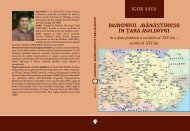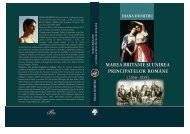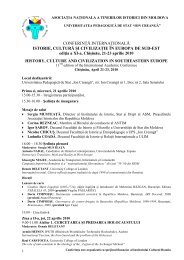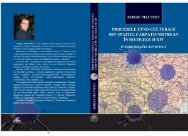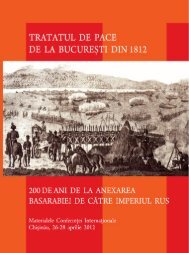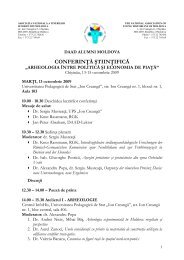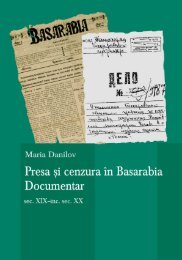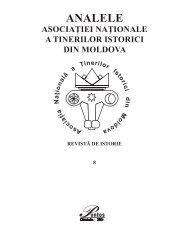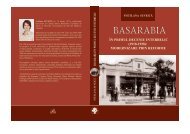LUCIA SAVA, Viaţa cotidiană în oraşul Chişinău la - Asociatia ...
LUCIA SAVA, Viaţa cotidiană în oraşul Chişinău la - Asociatia ...
LUCIA SAVA, Viaţa cotidiană în oraşul Chişinău la - Asociatia ...
Create successful ePaper yourself
Turn your PDF publications into a flip-book with our unique Google optimized e-Paper software.
234<br />
CONCLUSIONS<br />
Lucia Sava<br />
The analysis and the study of scientific works accessible sources, we made<br />
reference to in our study, allows us to highlight several conclusions regarding<br />
the evolution of the daily life of inhabitants of Chisinau in the early twentieth<br />
century (1900-1918).<br />
In that period, the city is facing a multitude of transformations of social,<br />
economic, political and cultural scale, which leads me to say, that Chisinau was<br />
the main urban center of Bessarabia and one of the most important centre of<br />
the Russian Empire. Despite unfavorable historical context, created following<br />
the intensification of Russification and the denationalization policies pursued<br />
by the Russian authorities, who had obvious interest in Bessarabia, historical<br />
events of the period 1905-1907 and the Revolution of 1917 years, have left<br />
fingerprints for the Romanian people of Moldova.<br />
The complex historical conditions have influenced also the daily lives of<br />
Chisinau, organized and led by models and complex principles. Elements of<br />
modernization at the beginning of the twentieth century, enter the entire city<br />
and are felt in appearance and in improving living standards of its inhabitants.<br />
Chisinau was built <strong>la</strong>rgely on the model of other cities of the Russian<br />
Empire: the buildings were separated by streets, grouped in neighborhoods<br />
and urban areas. Downtown was crowded, as there were concentrated most<br />
representative public buildings: City Hall, cathedral, court, theatres, cinema,<br />
library, stores, banks, leisure p<strong>la</strong>ces: pubs, cafes, etc. In this part of the town<br />
life’s rhythm is more exciting, here appear the first elements of modernization<br />
and transformation of the city into a true urban center (through construction<br />
of new roads, buildings, monuments, architectural styles change, etc.)..<br />
Following the efforts of the two main architects, A. Bernardazzi and A<br />
Sciusev, to rebuild the city, it changed its architectural appearance: Central<br />
Park is renovated, public gardens, huge buildings are built first, with modern<br />
look: from residential areas to public institutions. They also paved streets and<br />
main markets, parks and squares are arranged, some are lighted, etc.<br />
The construction’s technique was very precise, with the emphasis on<br />
quality, style and respect the symmetry, on the artistic taste. Reports of<br />
witnesses time is definitive proof of the existence of a mixture of different<br />
architectural trends, depending on the preferences of the owner or architect.<br />
All together, they meant to change the appearance of the city, giving it a<br />
touch of modernization.<br />
But the city suburbs show otherwise: the ulicioare narrow and winding,<br />
with small houses covered with shingle and reed, surrounded by gardens and



